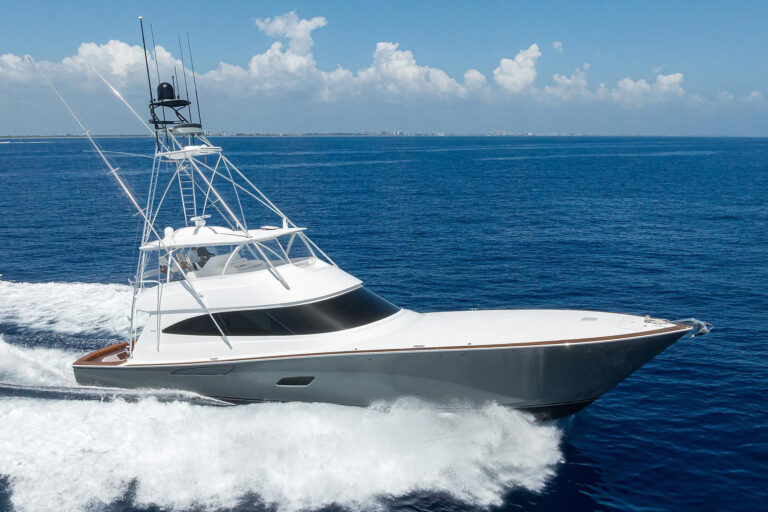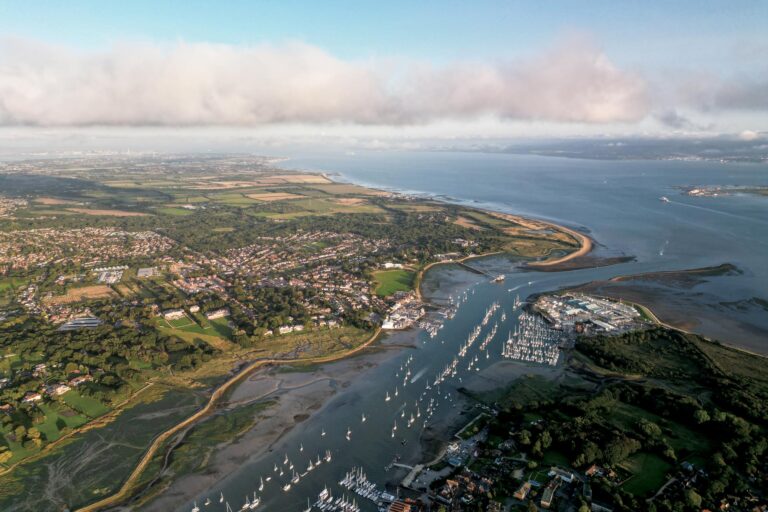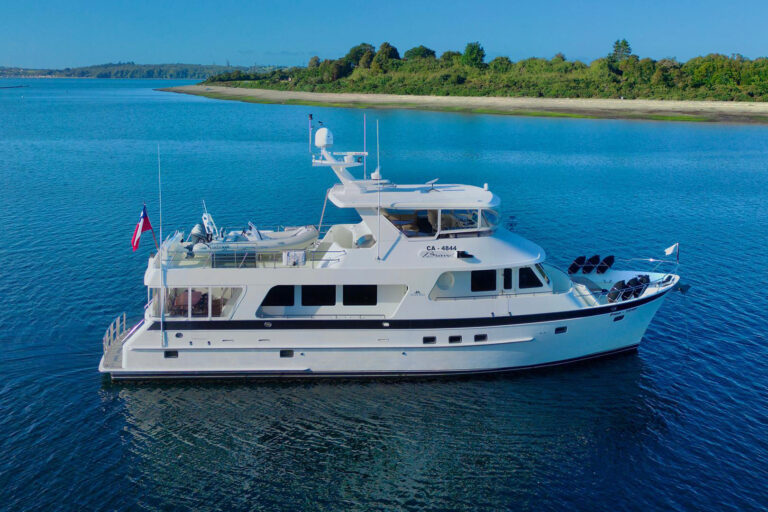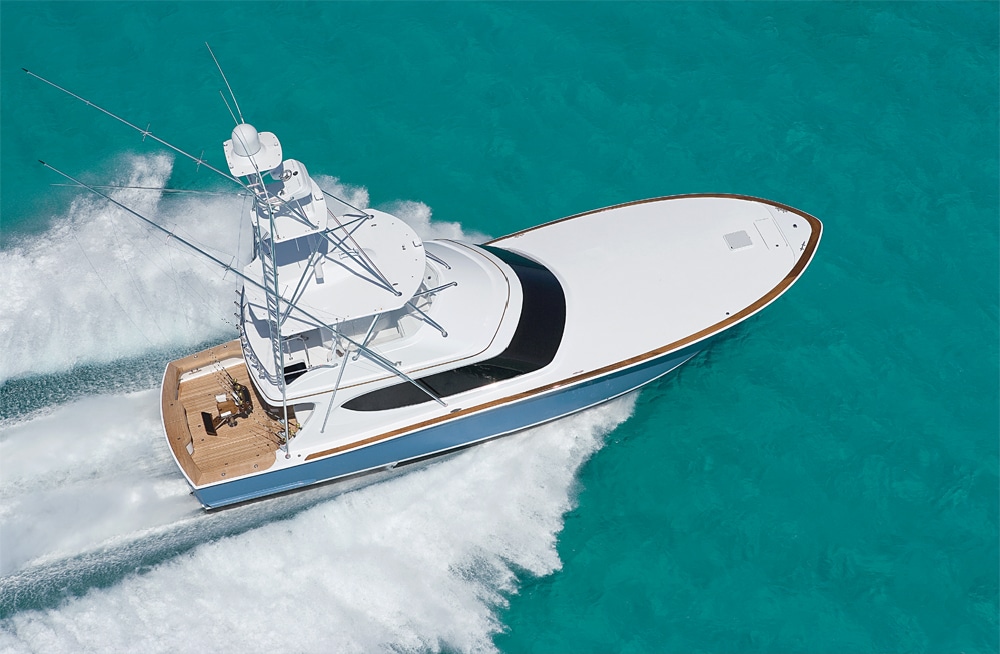
Hatteras GT63
The field of tournament fishing boats has become crowded in the past 10 years. Boatbuilding legends and young upstarts have been locked in battle, creating custom masterpieces with no expense spared. Production convertible builders have reinvented themselves by launching ever-faster and more sophisticated designs geared toward serious fishermen. Hatteras has stepped up to the plate with the GT series of designs, which includes a 54, a 60 and a new 63-footer I recently sea-trialed in south Florida. I have several Hatteras yachts on my short list of favorites — now I’ll have to make room for another.
Hatteras did its homework for the GT series, and the company suggests that it did not have to look far for inspiration. A handful of small custom yards on North Carolina’s Outer Banks have been building sport-fishing boats for a generation, and these days they compete head-to-head with custom tournament boatbuilders in southern Florida. Carolina boats are known for the tumblehome in their after sections and generous flam in their forward sections — “Carolina flare” in the local vernacular. Today the two regional schools have in many ways melded, setting new standards for styling, finish and performance. To my eye it is this standard that defines the GT63.
The sweep of the GT63’s sheer and her tumblehome aft are a tip of the hat to her birthplace; still, her Hatteras pedigree shines through. This DNA has its roots in the very first tournament boat designs — the first Hatteras was penned by the late designer Jack Hargrave, who began his career at the Rybovich yard in southern Florida. The cut of the GT63’s stem and the modest flare/flam in her forward sections are not overdone — they’re perfect. Her soft, sculptured house lines are not boxy or exaggerated — they’re balanced. In my opinion she is one of the best-looking boats Hatteras has launched in years.
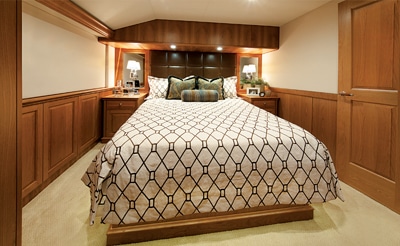
The GT series has a look and feel that is tailored to the high-end tournament market. Our test boat’s standard arrangement had four staterooms and three heads, with an en suite midship master and a larger stateroom forward. Two guest staterooms, with upper and lower berths, share a third head, which has access from the passageway. The main cabin is open, with a salon area aft and a galley and dinette forward. An optional layout with three staterooms and an office may be practical for some, while the optional three-stateroom arrangement with galley down seems a bit odd for a boat of this size. According to Hatteras, this arrangement is directed toward the European and Middle Eastern markets. Our test boat’s satin-finish, raised-panel cherry interior was beautifully crafted. Satin-finish mahogany is also available.
Hatteras’ objective was not simply to build tournament boats that looked the part. The GT series would have to be competitive in terms of performance, and the target was set at 41 knots. The challenge was that Hatteras has always favored building stout, tough boats, and weight is the enemy of speed. Many competitors building in fiberglass reduce weight by coring the bottom, but this was a nonstarter at Hatteras, where a solid bottom laminate has long been viewed as a selling point. To reduce weight, the design team re-evaluated its production methods with an eye to optimizing the lamination process.
Hatteras had been employing resin infusion technology in the production of small parts for a number of years and was comfortable with the prospect of infusing hulls, stringers and bulkheads. “The GT series infused hulls are 20 percent lighter than our hand-laminated hulls,” said Bruce Angel, vice president of product development and engineering. “We are achieving a 60/40 glass-to-resin ratio and a laminate that is almost twice as strong for a given thickness.” Closed-cell foam coring is used in the topsides, bulkheads and superstructure, and exterior surfaces are finished with a sprayed-on linear polyurethane coating.
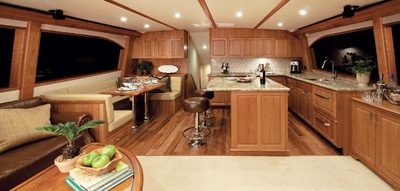
Hatteras was a pioneer in the development of fiberglass fuel tanks, so the integral fuel tank design used in the GT series seems to be a seamless and timely adaptation. The GT63’s single fuel tank is defined by the hull’s bottom and the inboard stringers, and it extends from the engine room to just forward of amidships. The fiberglass baffles and the top of the tank also serve as structure. The design saves weight, optimizes performance and simplifies fuel management. “The single integral tank allows us to place the fuel deeper in the hull, lowering the vertical center of gravity and [getting] closer to the longitudinal center of gravity,” said Angel, who points out that this enhances stability and illuminates the need to balance the fuel load to optimize running trim.
The design team also took a look at the GT series propulsion systems and running gear. Hatteras has long been a fan of deep reductions and large-diameter wheels. While this is an efficient way to transmit horsepower to the water, gear reductions in excess of 3:1 and the stout running gear that is required add up to more weight. “With a lighter overall structure to move through the water, we were able to use a lighter reduction,” Angel said. The GT63 has a gear reduction of 2.52:1, which is more typical of her competition. She is fitted with high-performance, high-blade- area wheels that are able to turn faster, consuming the same horsepower with less diameter.
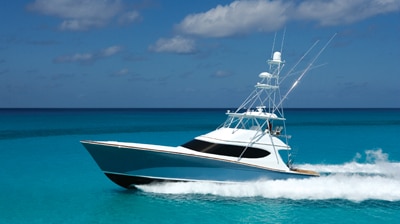
Our test boat was fitted with a full tower and a pair of 1,900-horsepower Caterpillar C32As — the most powerful of three Cat options offered. Her top speed was right on the money — 41 knots. At 2100 rpm I measured 38 knots, and the Cat electronics indicated a fuel burn of 168 gallons an hour. I found a more efficient setting at 32 knots (1800 rpm), burning 126 gallons an hour. Hatteras developed the GT63’s hull form with the help of naval architects Donald L. Blount and Associates, and a model of her hull was tank-tested at Stevens Institute of Technology. Her deadrise varies from 50 degrees forward to 8 degrees at the transom, and she has propeller pockets and a shallow keel.
All of this comes together at the GT63’s helm, where her generous dose of power and light weight relative to older Hatteras designs come into play. She is quick off the line, and we were running at speed without a fuss in little more than 12 seconds. She is agile, both at speed and in close quarters, and will have no problem backing down and twisting on a fish. Sight lines from her open bridge are excellent, and her tournament-style helm pod and single-lever controls will please those serious about fishing. For those a bit more serious about all-weather cruising comfort, the GT63 is available with an enclosed bridge.
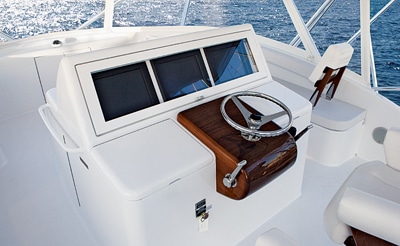
Hatteras likes to say that the boats in its GT series “are not your father’s Hatteras” — no argument there. While they pay homage to Carolina fish-boat tradition, in my opinion it is the Hatteras pedigree that makes the GT series special. One should expect a lot from a builder that helped invent the modern fiberglass yacht and coined the term convertible — Hatteras does not disappoint us with the GT63. In taking inspiration from the classics, it has created one.
LOA: 63’10”
LWL: 56’5″
Beam: 20’0″
Draft: 5’0″
Displ.: 102,000 lb.
Fuel: 1,900 gal.
Water: 270 gal.
Engine Options: 2 x 1,800 hp Caterpillar C32A diesels, 2 x 1,600 hp Caterpillar C32A diesels
Engines Tested: 2 x 1,900 hp Caterpillar C32A diesels
Price as Tested: $3.2 million
Hatteras Yachts, 252-633-3101; www.hatterasyachts.com
_View a complete gallery of the Hatteras GT63._
Subscribe to the Yachting Life newsletter for cruising and chartering guides, new boat announcements, event updates, special offers and more!





